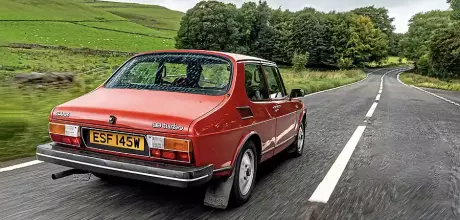1981 Saab 99 Turbo
Clive Moore has lusted after the Saab 99 Turbo for decades, so we put him behind the wheel of one for a day to see if it lived up to his dreams.
Words ANDREW NOAKES
Photography JONATHAN JACOB
‘If you don’t rev it enough you’re going nowhere. Keeping it spinning is the secret’
COVER The List Reader Clive Moore tries out a Seventies pioneer: the Saab 99 Turbo
Clive Moore re-learns driving technique in boosty Saab
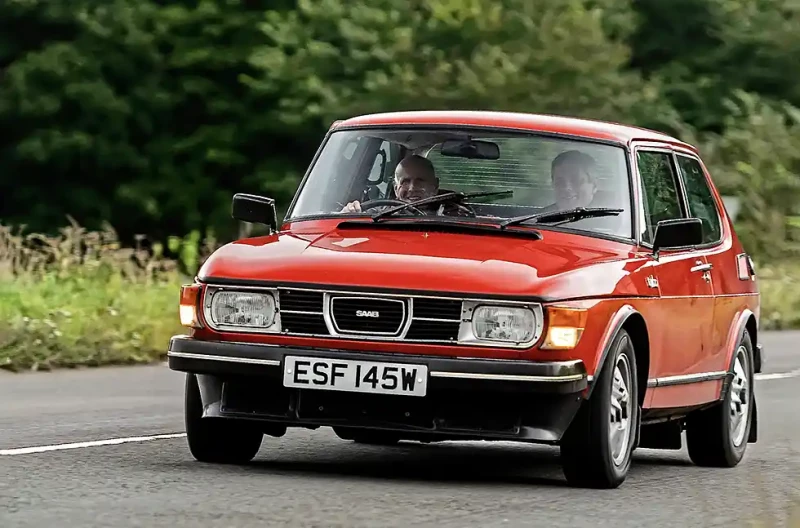
Classic Cars reader Clive Moore lives in North Wales, 50 miles from the nearest dual carriageway and almost 100 from a motorway. ‘It does ensure that there is an abundance of great driving roads nearby,’ he explains. ‘These roads are reflected in the cars that I have owned. I have never had any real exotic cars but I did have an affinity for hot hatches.’ His list of previous metal includes Peugeots 205GTI and 309GTI, a VW Golf GTD MkII and a ‘white lightning’ Ford Escort RS Turbo. So forced induction is nothing new to Clive, though the pioneering Saab 99 Turbo is a car he’s long lusted over but has never had the chance to drive. We’re putting that right today.
‘I could happily drive the four hours back home in it’
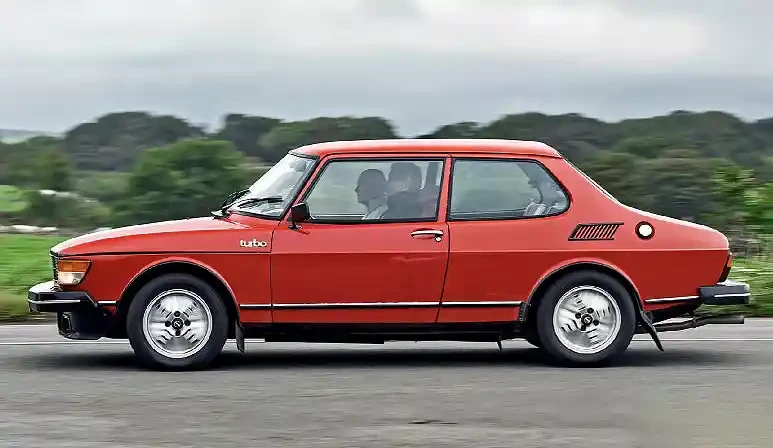
‘There’s no doubt that the Saab’s talents have been acknowledged by car magazines and testers over the years and I’m intrigued to see how it measures up to the claims,’ he says. Clive’s dream car list is wide ranging. ‘My list of top 10 cars includes those that I have either fond memories of, admired the most when I was younger, or would most wish to own should finances allow,’ he says. That encompasses everything from an early Range Rover (a step up in comfort from his own Land Rover Defender, which he says suits his active lifestyle and work with the RNLI) through classic sporting cars of the Sixties and Seventies to a genteel Rolls-Royce Silver Shadow.
‘When it was new it must have been quite a revelation compared to Escorts and Allegros’
A Saab gets into the top 10 because Clive has always admired Swedish cars for their safety and comfort, and for their early successes in rallying. ‘The appeal of the 99 Turbo was driven by a journey I made as a passenger in one of the first production models back in 1979,’ he remembers. ‘It was one of the first cars I aspired to, because of the engineering and the solidity of them. I used to go and watch rallies in the late Seventies and I remember seeing 99s competing in the hands of Stig Blomqvist and Per Eklund. They were a bit fragile in UK rallies but did OK elsewhere. It was Saab’s last works rally car before the arrival of the Audi Quattro made the two-wheel-drive machines obsolete.’
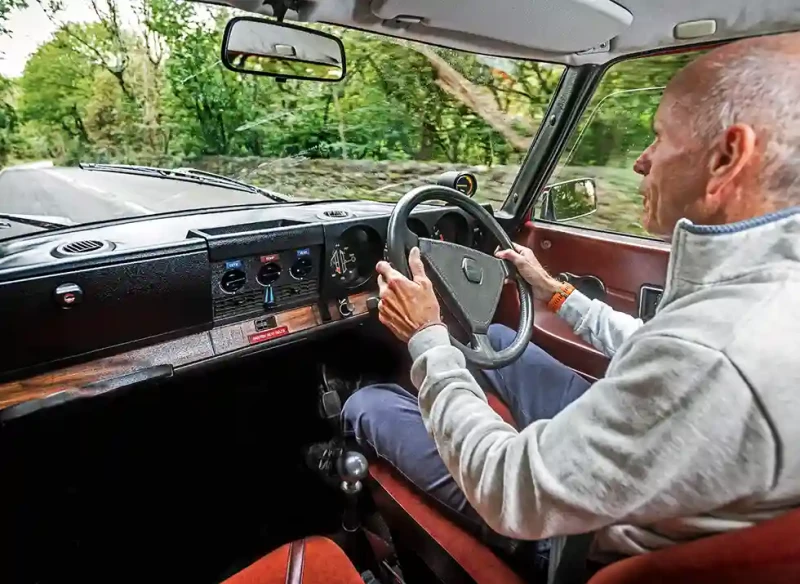
Alistair Gregory’s Carmine Red 99 Turbo is one of the twodoor cars that Saab produced to homologate the model for competition; three and five-door Turbos were also available. ‘It’s compact, and has a clean shape with little ostentation,’ says Clive. ‘It is quite subtle. Other than a discreet black air dam, the snazzy Inca alloy wheels and some badging there’s little to separate this from a run-of-the-mill 99. The Saab Turbo doesn’t shout at you like the established performance offerings from the likes of Porsche and BMW but, quietly, if offers genuine quality of engineering. Just look at the equipment it was offering as standard in 1978 – everything from four-wheel disc brakes and hazard flashers to halogen headlamps and a laminated screen.’
We pop the bonnet, a substantial forward-opening, clamshell affair, to take a look at the turbo motor underneath. The original 99 of 1968 used a mildly-modified version of Triumph’s slantfour engine, which subsequently went into the Dolomite. Saab produced its own 2.0-litre version in 1972. ‘Compared to the Triumph you can see how they reversed the engine, so the clutch is at the front and the gearbox is underneath, with the water pump moved to the side of the block for easier access,’ Clive points out. Saab planned a high-performance 99 with a Triumph Stag V8, but development didn’t get very far. ‘They made a few prototypes but then realised the turbo engine produced the same power with less weight and lower fuel consumption.’ Saab already had experience with Bosch fuel injection from the 99 EMS, and the Turbo adopted that together with Garrett’s new T3 turbocharger. It was the first turbo specifically engineered for car engines and much smaller than previous units which were designed for trucks. ‘They were after lots of mid-range torque rather than ultimate power,’ Clive explains. ‘Saab added a sophisticated control system for the turbo using a wastegate to limit the boost to 7.5psi.’
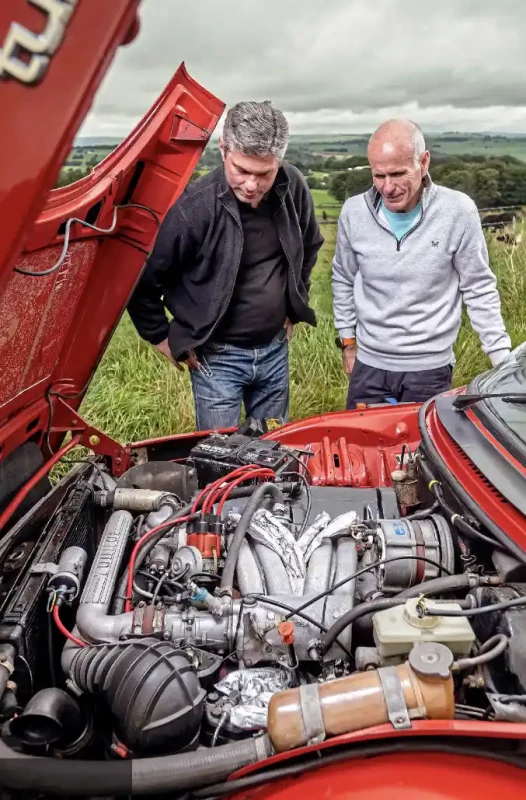
Clive pulls open the driver’s door, noticing that it runs the full depth of the side of the car so the sills are hidden. It’s one of Saab’s signature quirks that dates back to its first cars in 1949, and survived to the end of classic 900 production in 1993. ‘It’s a very airy cabin,’ Clive remarks as he settles into the tall-backed driver’s seat with its integrated head restraint. ‘The pillars of the heavily curved windscreen are quite far back, so you get a good view out, though I can’t see much of the bonnet. You’d have to be much taller to see where the nose ends.’
It's a typically Seventies interior, ‘Very much of the period with the generous use of plastics and velour trim. However, there is a solidity to how it has been put together from the sculptured door panels to these seats, which are supremely comfortable and offer all the right support. I immediately feel at home behind the wheel, which inspires confidence for the drive. The steering wheel is quite vertically raked, and the layout of the switches and instruments is very ergonomically sound – no doubt that’s a consequence of Saab’s origins as an aircraft manufacturer.’
‘It’s compact, and has a clean shape with little ostentation’
While the interior is generally welcoming, the orangey hue of the velour trim isn’t to Clive’s taste and he’s definitely not a fan of the fake wood applied to the Saab’s dashboard. ‘I’m not sure why it’s there,’ he says. ‘Perhaps an effort to add a touch of executive class to the interior? Swedes are stylish and they’ve got plenty of trees in Sweden, but they went and put this plastic stick-on stuff in it instead.’ But there are interesting details that lift the cabin beyond the humdrum. Clive points to the ‘fasten seatbelts’ warning light which was a rarity in the Seventies, the boost gauge on top of the dash that hints at the Turbo’s potential, and a mysterious switch labelled EXTRA, meant for controlling an accessory. Then there are the curious buckle-less seatbelts where you slide the loop of the belt into a clip between the seats. ‘That’s a very Swedish design,’ he says.

99 Turbo has many quirks, none of which are a dealbreaker for Clive. Andrew and Clive examine Saab’s take on the Triumph slant-four.Turbo gives 3-litre urge from 1985cc Saab 99 Turbo Curious ignition key placement bemuses Clive He detests the fake wood, ‘I’d be spraying that matt black.
‘And the ignition switch is down here behind the gearlever,’ Clive says. ‘It locks the gearbox, which has to be in reverse before you can remove the key.’ He gives it a twist and the 2.0-litre turbo four fires up with a hearty thrum. Manoeuvring the Saab out of its parking space takes a fair bit of effort because the steering is unassisted. ‘It’s heavy at slow speeds, as in all unassisted cars. The old technique of getting the car moving, even very slowly, before you try to turn the wheel helps a lot. The steering is quite low geared so there’s lots of wheel turning.’
Out on the road Clive reports that the steering quickly lightens up as the speed builds. ‘At low speeds you have to anticipate because the steering is heavy, otherwise you run out of road, but once you’re properly moving it lightens up. Then it’s nicely weighted with excellent feel and feedback. You soon get used to it. It wouldn’t put me off having one. The stop pedal requires a firm push too, but the brakes are there. Everything works well and the control weights are consistent.’
Clive is impressed by the Saab’s refinement. ‘It’s quiet,’ he says. ‘Not a lot of engine noise, not much tyre or wind noise. When it was new it must have been quite a revelation compared to Escorts and Allegros. It was pretty special at the time, I imagine.’
It’s what’s going on under the bonnet that’s really special, of course, but the turbo engine needs a driving technique all of its own. ‘Driven lazily there is nothing particularly inspiring with regards to the performance. As I remember the old turbos being, nothing happening and then all of a sudden it takes off. It’s flat at the bottom end of the rev range, and then at about 3000 revs it starts to pull and there’s a reassuring surge all the way to 5000rpm. If you don’t rev it enough before you change gear you drop out of the power band in the next gear and you’re going nowhere, which is a bit embarrassing in a car that can make good progress if youdrive it properly. Keeping it spinning is the secret.’ Do that and the Saab is decently swift, the engine note taking on a delicious snarl as the tacho needle swings upwards.
Ultimate performance is limited by its weight. ‘This is a substantial car. I had an early Escort turbo which had slightly less power, but it was considerably lighter. You’re not moving so much metal. But the Saab doesn’t have the torque steer you get in some hot hatches when pushing on through corners, perhaps because there’s a bit more weight over the front wheels. Road testers at the time talked about the steering needing a firm hand, so maybe it’s more stable because the tyres are better today. It feels nicely neutral, like a well sorted hot hatch, though it might get a bit unruly if the boost came in while you were cornering.’ Keeping the engine on the boil means making extensive use of the four-speed manual. ‘It’s a normal H-pattern with reverse towards me, with a short throw and narrow gate in line with the sporty nature of the car. But I’m struggling with it a bit,’ Clive admits. ‘Sometimes it’s not very precise, and doesn’t want to go into third. On the plus side the clutch is light and progressive.’
Apart from that tricky gearchange there are few serious demerits. The heater is one – it’s tricky to regulate. Then there’s that incongruous fake wood in the cabin. ‘If the car were in my ownership I’d have to address that,’ says Clive. ‘I’m usually a stickler for originality, but that would be on the hit list.’
But the Saab has certainly done enough to keep its place on Clive’s wish list. ‘I’m very impressed with it,’ he smiles. ‘It’s great to see a willingness by a manufacturer to buck the trend and do its own thing. The engine feels ideally geared to make use of the power available and the cabin is generally quiet at speed with a low level of engine and road noise. There is no doubt that it is at its best being hurried along country roads, but it would also be a capable cruiser. It would benefit from an additional higher gear or overdrive, but even so I could happily drive the four hours back home in it. I feel so comfortable in it, and you can cover ground quite quickly once you’re used to it. For a 40-year-old car it’s remarkable that it drives as well as it does.’
Thanks to: Bob Klonowski of Rebel Classics (rebel-classics.co.uk)
TCHNICAL DATA 1981 Saab 99 Turbo
- Engine 1985cc in-line four cylinder, sohc, Bosch K-jetronic fuel injection, Garrett T3 turbocharger
- Max Power 145bhp @ 5000rpm;
- Max Torque 174lb ft @ 3000rpm
- Transmission Four-speed manual, front-wheel drive
- Steering Rack and pinion
- Suspension Front: independent, double wishbones, coil springs, telescopic dampers, anti-roll bar. Rear: four-link beam axle, coil springs, Panhard rod, telescopic dampers
- Brakes Servo-assisted discs all round
- Performance Top speed: 122mph
- Acceleration 0-60mph 9.0 seconds
- Weight 1234kg (2716lb)
- Fuel consumption 24mpg
- Cost new £11,030 in 1981
- Classic Cars Price Guide £2200-14,000


